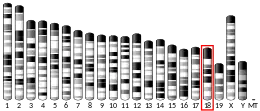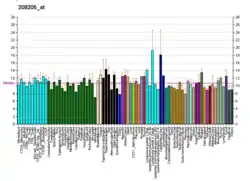PCDHA9
Protocadherin alpha-9 is a protein that in humans is encoded by the PCDHA9 gene.[5][6]
| PCDHA9 | |||||||||||||||||||||||||
|---|---|---|---|---|---|---|---|---|---|---|---|---|---|---|---|---|---|---|---|---|---|---|---|---|---|
| Identifiers | |||||||||||||||||||||||||
| Aliases | PCDHA9, PCDH-ALPHA9, protocadherin alpha 9 | ||||||||||||||||||||||||
| External IDs | OMIM: 606315 MGI: 2681879 HomoloGene: 129614 GeneCards: PCDHA9 | ||||||||||||||||||||||||
| |||||||||||||||||||||||||
| |||||||||||||||||||||||||
| |||||||||||||||||||||||||
| |||||||||||||||||||||||||
| Orthologs | |||||||||||||||||||||||||
| Species | Human | Mouse | |||||||||||||||||||||||
| Entrez | |||||||||||||||||||||||||
| Ensembl | |||||||||||||||||||||||||
| UniProt | |||||||||||||||||||||||||
| RefSeq (mRNA) | |||||||||||||||||||||||||
| RefSeq (protein) | |||||||||||||||||||||||||
| Location (UCSC) | Chr 5: 140.85 – 141.01 Mb | Chr 18: 36.99 – 37.19 Mb | |||||||||||||||||||||||
| PubMed search | [3] | [4] | |||||||||||||||||||||||
| Wikidata | |||||||||||||||||||||||||
| |||||||||||||||||||||||||
This gene is a member of the protocadherin alpha gene cluster, one of three related gene clusters tandemly linked on chromosome 5 that demonstrate an unusual genomic organization similar to that of B-cell and T-cell receptor gene clusters. The alpha gene cluster is composed of 15 cadherin superfamily genes related to the mouse CNR genes and consists of 13 highly similar and 2 more distantly related coding sequences. The tandem array of 15 N-terminal exons, or variable exons, are followed by downstream C-terminal exons, or constant exons, which are shared by all genes in the cluster. The large, uninterrupted N-terminal exons each encode six cadherin ectodomains while the C-terminal exons encode the cytoplasmic domain. These neural cadherin-like cell adhesion proteins are integral plasma membrane proteins that most likely play a critical role in the establishment and function of specific cell-cell connections in the brain. Alternative splicing has been observed and additional variants have been suggested but their full-length nature has yet to be determined.[6]
References
- GRCh38: Ensembl release 89: ENSG00000204961 - Ensembl, May 2017
- GRCm38: Ensembl release 89: ENSMUSG00000103800 - Ensembl, May 2017
- "Human PubMed Reference:". National Center for Biotechnology Information, U.S. National Library of Medicine.
- "Mouse PubMed Reference:". National Center for Biotechnology Information, U.S. National Library of Medicine.
- Wu Q, Maniatis T (Jul 1999). "A striking organization of a large family of human neural cadherin-like cell adhesion genes". Cell. 97 (6): 779–90. doi:10.1016/S0092-8674(00)80789-8. PMID 10380929. S2CID 6014717.
- "Entrez Gene: PCDHA9 protocadherin alpha 9".
Further reading
- Yagi T, Takeichi M (2000). "Cadherin superfamily genes: functions, genomic organization, and neurologic diversity". Genes Dev. 14 (10): 1169–80. doi:10.1101/gad.14.10.1169 (inactive 2021-01-14). PMID 10817752.CS1 maint: DOI inactive as of January 2021 (link)
- Nollet F, Kools P, van Roy F (2000). "Phylogenetic analysis of the cadherin superfamily allows identification of six major subfamilies besides several solitary members". J. Mol. Biol. 299 (3): 551–72. doi:10.1006/jmbi.2000.3777. PMID 10835267.
- Nagase T, Ishikawa K, Nakajima D, et al. (1997). "Prediction of the coding sequences of unidentified human genes. VII. The complete sequences of 100 new cDNA clones from brain which can code for large proteins in vitro". DNA Res. 4 (2): 141–50. doi:10.1093/dnares/4.2.141. PMID 9205841.
- Sugino H, Hamada S, Yasuda R, et al. (2000). "Genomic organization of the family of CNR cadherin genes in mice and humans". Genomics. 63 (1): 75–87. doi:10.1006/geno.1999.6066. PMID 10662547.
- Wu Q, Maniatis T (2000). "Large exons encoding multiple ectodomains are a characteristic feature of protocadherin genes". Proc. Natl. Acad. Sci. U.S.A. 97 (7): 3124–9. doi:10.1073/pnas.060027397. PMC 16203. PMID 10716726.
- Wu Q, Zhang T, Cheng JF, et al. (2001). "Comparative DNA sequence analysis of mouse and human protocadherin gene clusters". Genome Res. 11 (3): 389–404. doi:10.1101/gr.167301. PMC 311048. PMID 11230163.
- Strausberg RL, Feingold EA, Grouse LH, et al. (2003). "Generation and initial analysis of more than 15,000 full-length human and mouse cDNA sequences". Proc. Natl. Acad. Sci. U.S.A. 99 (26): 16899–903. doi:10.1073/pnas.242603899. PMC 139241. PMID 12477932.
- Schmutz J, Martin J, Terry A, et al. (2004). "The DNA sequence and comparative analysis of human chromosome 5" (PDF). Nature. 431 (7006): 268–74. Bibcode:2004Natur.431..268S. doi:10.1038/nature02919. PMID 15372022. S2CID 4373053.
- Gerhard DS, Wagner L, Feingold EA, et al. (2004). "The status, quality, and expansion of the NIH full-length cDNA project: the Mammalian Gene Collection (MGC)". Genome Res. 14 (10B): 2121–7. doi:10.1101/gr.2596504. PMC 528928. PMID 15489334.




